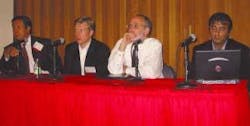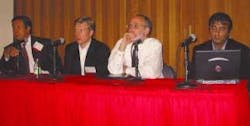Photonics meeting embarks upon platform for change
The current market woes have brought telecom-bashing into vogue. Speakers at the annual meeting of the Stanford Photonics Research Center (SPRC), however, seemed to tread the fine line of emphasizing the continuing technological and social importance of telecom while also keeping it in context among a broad multidisciplinary platform of optoelectronic technologies. In fact, the meeting platform was so broad that it ran a day longer than its traditional two-day span.
"This is the first year that we've run a three-day meeting, and we had to go to three days because the breadth of the photonics program at Stanford," said SPRC codirector Robert Byer. "The number of graduate students has increased dramatically over the last year; the number of courses we offer has increased and we've hired new faculty members in the area of photonics. So it really does represent a growth in the photonics program at Stanford."
This year, the meeting attracted about 220 attendees, about the same as last year's meeting held just days after the bombing of the World Trade Center towers in New York City. Ironically, even though the relatively low attendance figure was no more of a surprise in the currently difficult economic times than it was in the aftermath of last year's tragedy, it was still 30% above the annual meeting attendance in 2000, at the height of the telecom boom.
Fitzpatrick Photonics Institutes
The resilience of the Stanford photonics program through both tragedy and recession has no doubt been boosted significantly by a $25 million grant last year from Michael Fitzpatrick, former chief executive officer of E-tek Dynamics (San Jose, CA), and his wife. The couple made grants to Duke (Durham, NC) and Stanford Universities for the development of Fitzpatrick Photonics Institutes. Photonics researchers at Stanford took that initiative to incorporate a program primarily known for advances in nonlinear optics into a multidisciplinary photonics research center.
A long-term goal is to raise an additional $125 million to replace the 1950s-vintage temporary structures that currently house the laboratories with about 120,000 sq ft of research and learning spaces in a new Photonics Institute building. In the meantime, the grant has helped Stanford approach the current hard times with a strong sense of direction.
"The good news is that a lot of friends are coming back after a number of years of not being here," Byer said. "And they are recognizing that there are opportunities in the broad area of photonics." The "friends" Byer referred to include overseas researchers from institutions such as the University of Southampton (Southampton, England) and the Swiss Federal Institute of Technology (Zurich, Switzerland). They also include industry representatives, some of which, such as General Electric (Fairfield, CT), Texas Instruments (Dallas, TX), and Agilent Technologies (Palo Alto, CA) were new to the SPRC industry affiliates program.
The technical program at this year's meeting began with a national policy perspective from former presidential science advisor Duncan Moore, who currently heads the Center of Excellence in Photonics (Rochester, NY). Nobel Laureate and Stanford physics professor Steve Chu followed Moore with a review of basic photonics research. Several telecom technology presentations were followed by a photonics industry panel discussion chaired by Incubic (Mountain View, CA) founder Milton Chang. The meeting launched into nanophotonics, biophotonics, and optical microelectromechanical systems (MEMS) on the second day, before returning to its traditional roots on the third day in ultrafast and nonlinear optics, high-power laser applications, and nonlinear materials.
Technology platforms
Opening remarks by SPRC codirectors David Miller and Marty Fejer, as well as Moore in his plenary address, emphasized the key role of academia as a source of both research and researchers to fuel technology developments across a broad range of applications. Then Steve Chu started his basic-science keynote talk in the realm of laser cooling and Bose-Einstein condensates. The talk quickly focused, however, on how laser-cooling technology, through providing a platform for very precise measurements, has the potential for opening new application horizons in areas as diverse as timekeeping, gravity measurement, and molecular biology.
Mark Kasevich, who is in the process of moving from Yale (New Haven, CT) to Stanford, continued Chu's theme of atom optics, but with a specific focus on the development of a gravity gradiometer based on atomic de Broglie wave interference techniques. Real-time sensing of gravitational acceleration using such a system offers the possibility of extremely accurate inertial navigation systems that are relatively inexpensive and highly mobile compared to currently available technology, Kasevich said. He also showed results obtained with a prototype system sensitive enough for rapid mapping of gravitational anomalies from a low-flying aircraft.
null
Larry Coldren of the University of California, Santa Barbara (UCSB) and Agility Communications (Santa Barbara, CA) continued the platform theme while also providing a transition from opening talks on basic science to a half-day session on practical telecommunications devices. Coldren described the photonic integrated circuit (PIC) platform developed at UCSB and transferred to Agility four years ago for fabrication of monolithic widely tunable laser sources, integrated laser modules, and complete wavelength-converter PICs.
An industry panel at the end of the first day, chaired by Milton Chang, rang the same bell, when panelists Tom Baer of Arcturus Engineering (Mountain View, CA) and Asif Godil of Lightconnect (Newark, CA) emphasized the importance of coming to market with a platform technology rather than either a single product or even a suite of products. Godil cofounded Lightconnect with a diffractive MEMS technology platform that was originally developed at Stanford and was also used to start Silicon Light Machines (Sunnyvale, CA).
Baer said that he and Chang actually "started Arcturus with no specific product ideas." What they had wÎas a concept of using photonics in the life-science sector, and a product platform based on laser-capture microdissection. Baer's comments also added a multidisciplinary aspect to the overall theme of building platforms. On his way to becoming CEO of a successful biophotonics start-up company, Baer essentially left photonics for more than a decade to immerse himself in biological disciplines. Baer's comments along these lines seemed to hearken back to Moore's presentation on the kinds of multidisciplinary efforts that will be required to launch a national photonics initiative (see "Optical workforce problem calls for individual and community action," p. 71). "Multidisciplinary," Moore said, "is not just electrical engineers working with physicists."

